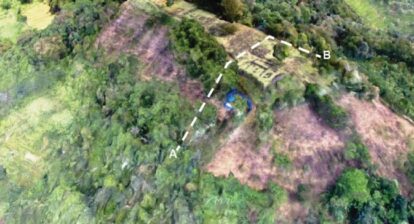Around 900 years ago, an extensive and sophisticated culture existed across the Mississippi River from present-day St. Louis, home to approximately 50,000 people in the metropolitan area. This was Cahokia, one of the largest communities in the world at that time. However, around 1400, this bustling, once popular site, was deserted. Why this mass exodus happened, remains shrouded in mystery.
The Missippian way of life developed along the Mississippi River Valley long before Hernando de Soto explored the area (1539-1540). The Mississippian culture was a Native American civilisation that flourished in what is now the Midwestern, Eastern, and Southeastern United States from approximately 800 to 1600 CE, though it varied regionally. This culture developed advanced societies across much of what is now the Central and the Southeastern United States, beginning more than 1,000 years before European contact.

A map showing approximate areas of various Mississippian and related cultures. Cahokia is located near the center of this map in the upper part of the Middle Mississippi area.

A Mississippian-era priest, in the 13th century, Cahokia metropolis, holding a ceremonial flint mace and severed sacrificial head
Not only was it composed of a series of urban settlements, it also included satellite villages, all linked together by a loose trading networks. The entire culture built large earthen platform and other shaped mounds. Cahokia was the largest and most influential urban settlement of the Mississippian culture. It is thought that Cahokia was a major religious centre and was located in present-day southern Illinois, just across the Mississippi River from present-day St. Louis. At its peak the Cahokia Mounds settlement bustled with roughly 50,000 people in the metropolitan area, making it one of the largest communities in the world.
There is some evidence that Cahokia was occupied around 1200 BCE but, but as it is defined now, it was properly settled around 600 CE. At around the 9th century CE, mound building began, coinciding with the emergent Missippian cutlure. Although the residents did not leave any written records, they did leave pottery, marine shells, copper, wood and stones with symbols on them. While we cannot understand them through these symbols, the elaborately planned community with their woodhenge, mounds, and burials reveal a complex and sophisticated society. Today, the Cahokia Mounds are considered to be the largest and most complex archaeological site north of the great pre-Columbian cities in Mexico.

Artists conception of the Mississippian culture Cahokia Mounds Site in Illinois. The illustration shows the large Monks Mound at the center of the site with the Grand Plaza to it’s south. This central precinct is encircled by a palisade. Three other plazas surround Monks Mound to the west, north and east. To the west of the western plaza is the Woodhenge circle of cedar posts. Digital illustration. All rights held by the artist, Herb Roe © 2018

Cahokia winter solstice sunrise over Fox Mound and the Cahokia Woodhenge ca. 1000 AD. Artist’s concept.
However, By 1400, however, the once-popular site was practically deserted, a mass exodus that remains shrouded in mystery.
Chankillo – The Oldest Sun Observatory in the Americas
So, what happened to Cahokia by 1400 that the entire site was practically deserted?
There has been a popular theory that the Cahokia residents abandoned their settlement due to a prolonged drought that led to a massive crop failure.
But a new study by Natalie Mueller, assistant professor of archaeology, and Caitlin Rankin, suggests the Cahokians likely had other reasons to leave town.
“Given the diversity of their known food-base, the domesticated landscape around Cahokia may have been resilient in the face of climate change and capable of producing more food than was required by Cahokians,” write the researchers in their published paper.
For this new study, the team analysed the soil at the site for isotopes of Carbon 12 and Carbon 13, left behind by the plants growing at the time of the population collapse and when drought was common in the Midwest.
According to the study: “All plants use one of two types of carbon, Carbon 12 and Carbon 13, for photosynthesis, but not all plants do photosynthesis the same way. Plants adapted to dry climates— including prairie grasses and maize, an important new crop during the Cahokia period — incorporate carbon into their bodies at rates that leave behind a tell-tale signature when the plants die and decay.”
The analysis showed that ratios of Carbon 12 and Carbon 13 in the plants that the Cahokians would have harvested for food, including squash, goosefoot, and sumpweed stayed relatively consistent during this period. This showed that there was no radical shift in the type of plants.
“We saw no evidence that prairie grasses were taking over, which we would expect in a scenario where widespread crop failure was occurring,” Mueller said.
According to the researchers, the Cahokians are known for their ingenuity and may have had the engineering and irrigation skills to keep crops flourishing under difficult conditions. “It’s possible that they weren’t really feeling the impacts of the drought,” said Rankin.
Furthermore, they almost certainly had a storage systems for grains and other foods and “residents also enjoyed a varied and diverse diet — including fish, birds, deer, bear, and forest fruits and nuts — that would have kept them nourished even if a few food sources disappeared“.
While it seems that drought was not the culprit, the study did not answer the question of what actually happened. The researchers suspect that it was a gradual process. “I don’t envision a scene where thousands of people were suddenly streaming out of town,” Mueller said. “People probably just spread out to be near kin or to find different opportunities.”
“They put a lot of effort into building these mounds, but there were probably external pressures that caused them to leave,” Rankin said. “The picture is likely complicated.”
Mueller now hopes to build a database that collects paleo-botanical evidence from across the region in order to better understand the diets and agricultural practices of midwestern indigenous populations.
“Gathering that information would help us see if people switched to different crops in response to climate change,” she said. She’s also planning to grow certain food crops in controlled conditions on campus to understand how they might have responded to ancient droughts and other challenges.
In the present day, the Cahokia Mounds State Historical Site is a historical park covering 2,200 acres (890 ha), or about 3.5 square miles (9 km2), and contains about 80 manmade mounds, However, the ancient city was much larger. At around 1100 CE, when it was at its peak, the city covered about 6 square miles (16 km2). It included around 120 earhworks of various shapes, sizes and functions. At this time, the population was around 15,000 to 20,000 people.

Incised sandstone tablet of a Birdman found in 1971 during excavations into the east side of Monks Mound

Clay statuette excavated at Cahokia site

Three examples of Mississippian culture avian themed repousse copper plates. The righthand figure is from the Spiro Mounds in Oklahoma. The left hand figure Wulfing plate A, one of Wulfing cache from Malden, Missouri. The middle plate is Rogan plate 1, from Etowah Mounds in Georgia. Examples of this type of artwork have been found as artifacts in several states in the Midwest and Southeast.
Cahokia Mounds is a National Historic Landmark and a designated site for state protection. It is also one of the 25 UNESCO World Heritage Sites within the United States.







